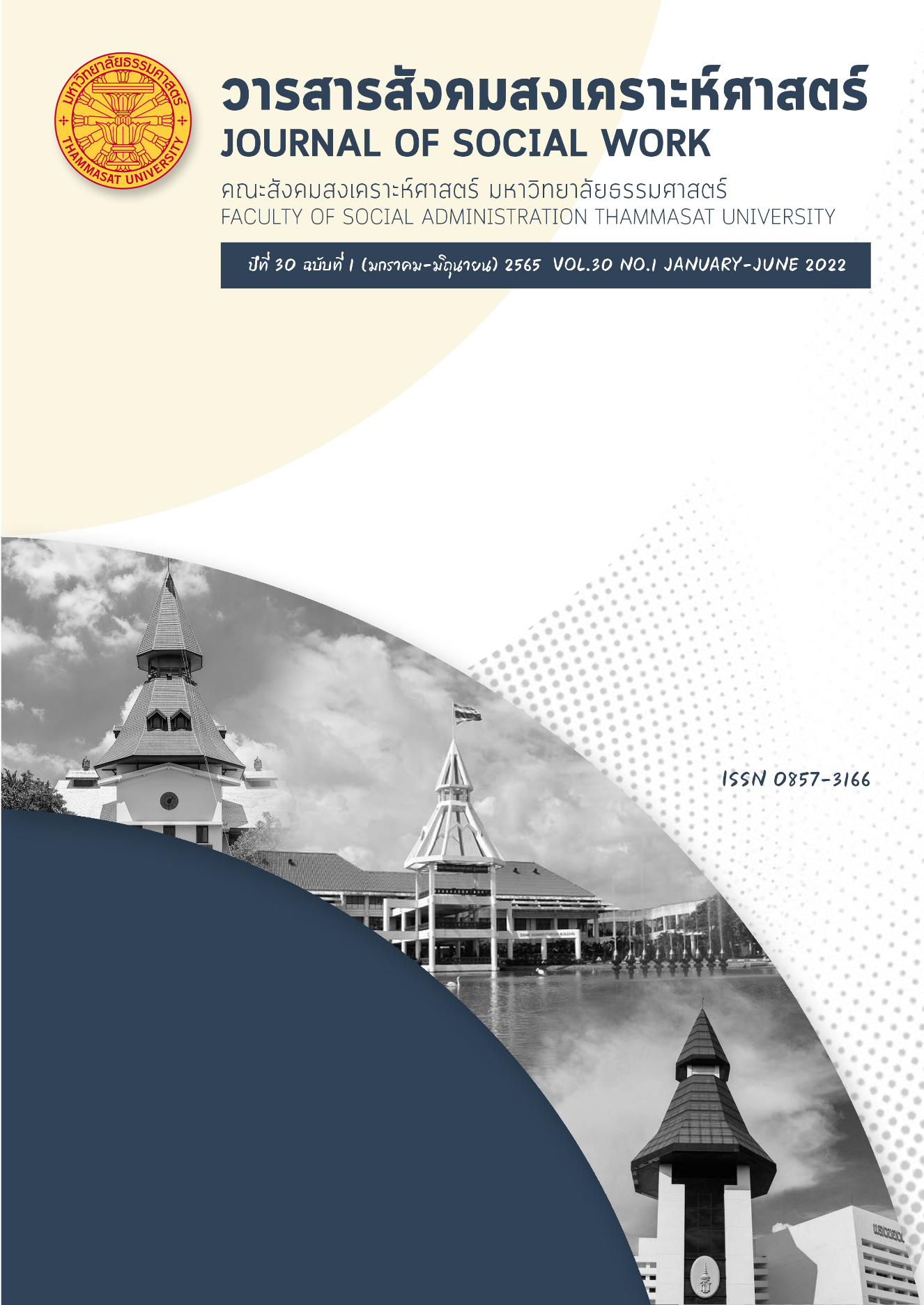Self-Directed Learning in Online Learning among Students of Faculty of Social Administration, Thammasat University
Keywords:
Self-directed learning, Online Learning, The Public Mind for Students, Faculty of Social AdministrationAbstract
The purpose of this research is to explore self-directed learning in online learning among students of the Faculty of Social Administration, Thammasat University with the aim to; 1) study self-directed learning in online learning among students, 2) investigate and make comparisons between factors and self-directed learning in online learning among students, and
3) search for correlations between the environment, stress, and self-directed learning in online learning among students. Samples are taken from 312 students from 1st-4th year students, Academic Year 2020 of the Faculty of Social Administration, Thammasat University from both Rangsit Campus and Lampang Campus. The instrument used in this research is a questionnaire. Statistics used for the analysis are; t-test Statistic, One -Way Analysis of Variance ANOVA, and Pearson Product Moment Correlation Coefficient. The research result is as follows; 1) Self-directed learning in online learning among students is at a moderate level. When considering each aspect, it appears that students have the most self-directed learning aspect of online learning in regard to the responsibility for learning, followed by the aspect of the passion for learning and the aspect of the opportunity for learning as the least one. 2) There are significant differences between the factors related to the study center and computer aptitude affecting self-directed learning in online learning among students, while the factors of education level and the student's cumulative GPAX have no effect on self-directed learning in online learning. 3) All aspects of the online learning environment, including the environment of the instructor, the environment of group of friends, and the environment of resources in online learning has correlations with self-directed learning in online learning, while stress has no correlations with self-directed learning in online learning among students.
References
คมสิทธิ์ สิทธิประการ, วิกรม ฉันทรางกูร และภัชญาภา ทองใส. (2563). ผลสัมฤทธิ์การเรียนการอ่านขั้นสูงของนักศึกษาผ่านบทเรียนออนไลน์. วารสารสังคมศาสตร์และมานุษยวิทยาเชิงพุทธ, 5(11), 185-198.
ธัญจิรา จิรนันทกาญจน์. (2559). การใช้แบบเรียนออนไลน์ในการศึกษาแพทยศาสตร์. เวชบันทึกศิริราช, 9(2), 98-106.
ปรินดา ตาสี. (2551). ลักษณะทางจิตและสภาพแวดล้อมทางการเรียนที่เกี่ยวข้องกับความพร้อมในการเรียนรู้ด้วยการนำตนเองของนักศึกษาชั้นปีที่ 1 ของมหาวิทยาลัยในกรุงเทพมหานคร. ปริญญาวิทยาศาสตร์มหาบัณฑิต สาขาวิชาการวิจัยพฤติกรรมศาสตร์ประยุกต์, มหาวิทยาลัยศรีนครินทรวิโรฒ.
พิมพ์พรรณ เทพสุเมธานนท์ และ สุพิชชา ประสิทธิธัญกิจ. (2553). ศึกษาเรื่องการเรียนรู้ด้วยการนําตนเองของนักศึกษาภาควิชาพื้นฐานการศึกษา คณะศึกษาศาสตร์ มหาวิทยาลัยรามคําแหง. กรุงเทพฯ: มหาวิทยาลัยรามคําแหง.
พัชนี อ่ำแก้ว. (2553). ปัจจัยด้านคุณลักษณะในตนเองและด้านสิ่งแวดล้อมทางการเรียนที่ส่งผลต่อความพร้อมในการเรียนรู้ด้วยตนเองของนักเรียน โรงเรียนสาธิตมหาวิทยาลัยเชียงใหม่. ศึกษาศาสตร์มหาบัณฑิต สาขาวิชาวิจัยและสถิติการศึกษา, มหาวิทยาลัยเชียงใหม่.
มหาวิทยาลัยราชภัฎรำไพพรรณี. (2563). การเรียนออนไลน์. สารสำนักวิทยบริการและเทคโนโลยีสารสนเทศ, 9(2), 10.
Bull, Shirley, Solity, Joanthan. (1987). Classroom Management: Principles to Practice. New York: Croom Helm.
Cogen, M. L. (1975). Studies of Teacher Behavior. The Journal of Experimental Education, 34(2), 135-139.
Council on Social Work Education [CSWE]. (2014). Draft 3 of the 2015 Educational Policy and Accreditation Standards (EPAS). Alexandria, VA: Author.
Curtis, J. Bonk, Mimi Miyoung, Lee, Xiaojing, Kou, Shuya, Xu, & Feng-Ru, Sheu. (2015). Understanding the Self-Directed Online Learning Preferences, Goals, Achievements, and Challenges of MIT Open Course Ware Subscribers. Educational Technology & Society, 18(2), 349–368.
Dixon, W. B. (1992). An exploratory study of self-directed learning readiness and pedagogical expectations about learning among adult inmate learners in Michigan. Michigan: Michigan State University.
Fisher, M. King, J. and Tague, G. (2001). Development of a Self-Directed Learning Readiness Scale for Nursing Education. Nurse Education Today, 21(1), 516-525.
Garrison, D. R. (1992). Critical thinking and self-directed learning in adult education: An analysis of responsibilities and control issues. Adult Education Quarterly, 42(3), 136-148.
Good, Carter v. (1973). Dictionary of Education. New York: McGraw-Hill, Inc.
Guglielmino, L. M. (1977). Development of the Self-Directed Learning Readiness Scale. Georgia: University of Georgia.
Hans, Selye. (1956). The stress of life. New York: McGraw-Hill.
Hudspeth, & Jerald, Henry. (1992). Student Outcomes: The Relationship of Teaching Style to Readiness for Self-Directed Learning. Dissetation Abstracts International-A. (CD-ROM).
Jivanjee, P., Pendel, K., Nissen, L., & Goodluck, C. (2016). Lifelong Learning in Social Work: A Qualitative Exploration with Social Work Practitioners, Students, and Field Instructors. Advances in Social Work, 16(2), 260-275.
Kathleen, Cercone. (2008). Characteristics of Adult Learners with Implications for Online Learning Design. AACE Review (formerly AACE Journal), 16(2), 137-159.
Knowles, M. S. (1975). Self-Directed Learning: A Guide for Learners and Teacher. Chicago: Association Press.
Lawrenz, Frances. (1976). Student Perception of the Classroom Learning Environment in Biology, Chemistry and Physics courses. Journal of Research in Science Teaching. 13(4), 315-323.
Marlene, Schommer-Aikins, & Marilyn, Easter. (2018). Cognitive Flexibility, Procrastination, and Need for Closure Linked to Online Self-directed Learning Among Students Taking Online Courses. Journal of Business and Educational Leadership, 8(1), 112 - 123.
Merriam, S. B. (2001). Andragogy and self-directed learning. New Directions for Adult and Continuing Education, 89(1), 3-14.
Michael, Posner, Steve, E. Petersen. (1990). The Attention System of the Human Brain. Annual Review of Neuroscience, 13(1), 25-42.
Moos, R. H., & Moos, B. S. (1978). Classroom social climate and student absences and grades. Journal of Educational Psychology, 70(2), 263–269.
Oddi, L. F. (1987). Perspectives on Self-Directed Learning. Adult Education Quarterly, 38(1), 21–31.
Pao-Nan, Chou. (2012). Effect of Students’ Self-Directed Learning Abilities on Online Learning Outcomes: Two Exploratory Experiments in Electronic Engineering. International Journal of Humanities and Social Science, 2(6), 172-179.
Rogers, C. R. (1969). Freedom to learn. Columbus: Charles E. Merrill Publishing Co.
Rosemary, Kim, Lorne, Olfman, Terry, Ryan, & Evrenม Eryilmaz (2014). Leveraging a personalized system to improve self-directed learning in online educational environments. Computers & Education, 70(2), 150–160.
Susan, T. Fiske, Shelley, E. Taylor. (1991). Social Cognition. New York: McGraw-Hill Series in Social Psychology.
Veronica, McCauley, & George, McCelland. (2004). Further Studies in Self-Directed Learning in Physics at the University of Limerick, Ireland. International Journal of Self-Directed Learning, 1(2). 26-37.
Downloads
Published
How to Cite
Issue
Section
License
Copyright (c) 2022 Journal of Social Work

This work is licensed under a Creative Commons Attribution-NonCommercial-NoDerivatives 4.0 International License.
The manuscripts published in the Social Work Journal is the copyright of the Social Work Journal, Thammasat University
Any article or opinion appeared in the Social Work Journal will solely be under the responsibility of the author The Faculty of Social Administration, Thammasat University and the editors do not need to reach in agreement or hold any responsibility.



